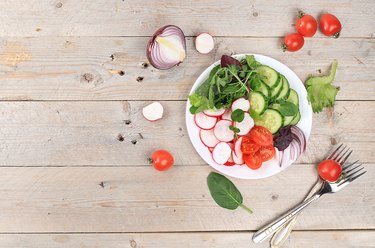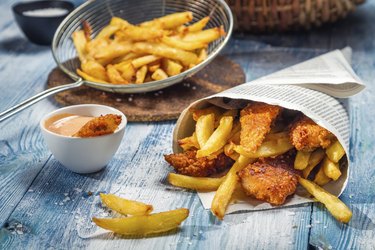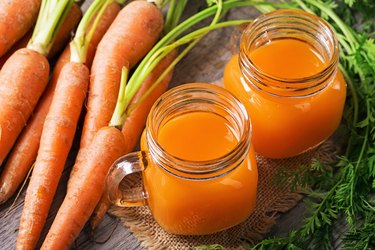Diverticulitis is debilitating, so its important that your diet wont make it worse. If you like steak or a cooked breakfast, you should find out if there is a link between red meat and diverticulitis or between bacon and diverticulitis. The answer seems to be: “Its complicated. “.
When you have a diverticulitis flare-up, meat and poultry are safe foods to eat because they are low in fiber. You might not want to eat a lot of red meat, though, if you don’t already have diverticulitis and don’t want to get it.
The National Institute of Diabetes and Kidney Diseases (NIDDK) says that diverticular disease is a general term for the symptoms of diverticulosis and diverticulitis in the gut. Sometimes, small pouches (called diverticula) form and push out through weak spots in the wall of your colon (bowel). This is called diverticulosis.
You are more likely to get diverticulosis as you get older; 58% of people over 60 have it. These signs happen when one or more of the pouches in the wall of your colon get inflamed. This is called diverticulitis.
The NIDDK says that you may have diverticulosis and have no symptoms, or you may have constipation, diarrhea, abdominal pain, and bloating. Though only a small percentage of people with diverticulosis go on to get diverticulitis, it usually causes very bad stomach pain. Diverticular bleeding can also occur as a symptom of diverticular disease.
Diverticulitis is a common digestive condition where small pouches called diverticula become inflamed or infected in the colon It affects over half of all people over age 60 Diverticulitis can cause painful abdominal symptoms like cramping, bloating, and changes in bowel habits. Unfortunately, this means certain foods may need to be limited or avoided during flare-ups to help manage symptoms. But what about indulgent seafood like lobster? Can you still enjoy lobster tail or lobster bisque if you have diverticulitis? Let’s dive into the details.
An Overview of Diverticulitis
Diverticulitis occurs when diverticula, or small bulging pockets, form in the lining of the colon and become irritated and inflamed. This often happens when stool or bacteria become trapped in the pouches Diverticulitis shares some similarities with other digestive conditions like IBS and IBD, but has some key differences.
Some facts about diverticulitis:
-
Primarily affects the large intestine and colon rather than the small intestine.
-
Risk increases with age, being over 50 years old.
-
Leading symptom is abdominal pain, usually in the lower left side.
-
Can lead to complications like abscesses, perforations, fistulas, or blockages.
-
Main treatments include antibiotics, bowel rest, pain management, and sometimes surgery.
Diet and lifestyle factors like smoking and inactivity also contribute to one’s risk of developing diverticular disease. Recurring bouts of diverticulitis over time can disrupt quality of life. Identifying individual food triggers is important for prevention and symptom management.
Lobster and Diverticulitis Diet Recommendations
So how does decadent, buttery lobster factor into a diverticulitis-friendly diet? Here are some general guidelines:
During Acute Flare-Ups
-
Avoid lobster and other high-fiber foods: Stick to a clear liquid or low-fiber diet until your symptoms subside. Lobster contains more fiber than lean meats, so it’s not the best option.
-
Focus on low-fiber proteins: Opt for tender meat, poultry, eggs, tofu or fish like cod or flounder that are easier to digest.
-
Reduce insoluble fiber: Insoluble fiber from skin, shells, seeds and husks can irritate inflamed pouches. Go for peeled, seedless fruits and veggies.
-
Limit fat: High-fat foods like lobster bisque may worsen cramping or diarrhea. Stick to lean, baked or broiled preparations.
In Remission Between Flare-Ups
-
Slowly reintroduce high-fiber foods: Gradually add back higher fiber items over several weeks under your doctor’s guidance.
-
Try peeled, cooked lobster meat: The fiber is in the shell. Enjoy lobster meat in moderation as a lean protein.
-
Avoid triggers: Skip lobster or any items that seem to aggravate your symptoms. Keep a food journal to identify your triggers.
-
Eat the rainbow: Emphasize fruits, vegetables, beans, whole grains and nuts to meet daily fiber needs of 25-30 grams.
-
Stay active and maintain a healthy weight: Exercise and avoiding obesity can help prevent recurrent diverticulitis.
Nutritional Profile of Lobster
So what exactly makes up the nutritional content of lobster? Here’s a breakdown:
-
High in protein: Provides over 20g protein per 3oz serving. Essential for tissue repair and immunity.
-
Low in fat: Has less than 1g saturated fat per serving. Much leaner than fatty cuts of beef or pork.
-
Rich in vitamins and minerals: Excellent source of copper, selenium, zinc, vitamin B12 and vitamin B6. Provides some calcium, iron and magnesium.
-
Contains omega-3s: Provides anti-inflammatory fats like DHA and EPA, but less than fatty fish like salmon.
-
Moderate fiber: Has 1-2g fiber per serving. More than chicken or fish, but less than beans, fruits or vegetables.
-
Low calorie: Around 100 calories in 3oz of lobster meat. Supportive of weight management.
Overall, lobster does provide lean protein, vitamins and minerals. But its moderately high fiber content may be tricky with diverticulitis. Portion size and preparation method also impact its tolerance.
Tips for Safely Consuming Lobster with Diverticulitis
Here are some tips to enjoy lobster without flaring up diverticulitis symptoms:
-
Stick to a 3-4 oz serving size of lobster meat without the shell.
-
Steam, boil or bake instead of frying in oil or butter to decrease fat.
-
Avoid lobster bisque or preparations with rich sauces, as fat exacerbates symptoms.
-
Remove any flesh near shells, legs or internal veins which are higher in fiber.
-
Introduce lobster slowly back into your diet between flare ups, and stop if it causes symptoms.
-
Take a digestive enzyme supplement containing amylase, lipase and protease to better break down the lobster.
-
Pair lobster with gut-friendly sides like white rice, potatoes or cooked carrots or zucchini.
-
Stay well hydrated and avoid alcohol, as this can contribute to constipation.
Being attentive to your personal tolerance and sensitivities is key to integrating lobster and other higher fiber foods back into your diverticulitis diet safely.
Foods to Avoid with Diverticulitis
While a serving of lobster can potentially be tolerated between flare ups, there are certain foods that should consistently be limited or avoided with diverticulitis:
-
Nuts and seeds – These small, hard foods can wedge into diverticula and cause irritation.
-
Red meat – Associated with a higher risk of diverticulitis complications compared to poultry and fish.
-
Processed meats like deli meat and sausage – Also linked to increased risk and recurrence of diverticulitis.
-
Popcorn and snack foods with small seeds or shells – Can lodge in pouches and cause inflammation or micro-perforations.
-
Whole grain foods with bran – Insoluble fiber in the bran may aggravate symptoms. Opt for refined grains.
-
Raw fruits and vegetables – The skins, membranes and seeds are made of insoluble fiber. Cooked is better tolerated.
-
Dried fruits – Their skin and condensed fiber concentrate during dehydration can be harsh on sensitive intestines.
Paying attention to foods that tend to worsen your personal symptoms is key. Keeping a food and symptom journal can help identify your unique triggers.
Lifestyle and Prevention Tips for Diverticulitis
Diet is just one piece of the puzzle when it comes to managing diverticular disease. Here are some other tips for prevention and reducing flare-up risk:
- Exercise regularly to keep your digestive system moving.
- Maintain a healthy body weight. Extra abdominal fat increases pressure in the colon.
- Don’t smoke or limit alcohol which are risk factors.
- Take a daily fiber supplement and stay hydrated for softer, bulkier stools.
- Manage chronic stress and get enough sleep to support your immune health.
- Consider probiotic supplements to improve your gut microbiome’s resilience.
Talk to your doctor about individualized lifestyle, dietary and medical recommendations to keep diverticulitis under control. This will provide the flexibility to enjoy lobster and other favorite foods in moderation.
The Takeaway on Lobster and Diverticulitis
Moderately portioned, peeled lobster meat can potentially be tolerated between symptom flare-ups of diverticulitis. Its lean protein and nutrient density provide benefits. However, the higher insoluble fiber content of lobster shells should still be avoided. During acute episodes, stick to a low-fiber diet until symptoms resolve. Then gradually reintroduce lobster meat and other higher fiber foods while monitoring your tolerance. Aim for a balanced diet with 25-30 grams of daily fiber focused on fruits, vegetables, beans and whole grains. With individualized diet and lifestyle tweaks, dealing with diverticulitis doesn’t have to get in between you and enjoying the occasional lobster tail.

Preventive Diet for Diverticular Disease
While a low-fiber diet can help with acute diverticulitis flare-ups, the NIDDK suggests that a high-fiber diet might be better for people who already have diverticulosis and want to try to keep diverticulitis from happening.
Increasing the amount of fiber you eat shouldn’t be done unless you are having severe symptoms and have talked to your doctor first, because the benefits aren’t always clear. Also, a doctor may need to keep an eye on how much and how quickly you add fiber to your diet to make sure you don’t get stomach pain and gas.
Because meat doesn’t have fiber, you shouldn’t eat too much of it. Instead, make room on your plate for plant-based protein sources that do have fiber.
The Mayo Clinic says the way that high-fiber foods, such as fruits, vegetables, whole grains and soya help is by softening waste, helping it pass more quickly through your colon. This reduces pressure within your digestive tract, which may help reduce the risk of diverticula forming and becoming inflamed.
People with small pouches in the lining of their colon were once told to stay away from nuts, seeds, and popcorn, according to the Mayo Clinic. This was because it was thought that these foods could get stuck in the pouches and cause irritation and inflammation.
New research, on the other hand, suggests that these healthy foods do not cause diverticulitis. People who already have diverticulitis can and should eat them every day.
Another option worth exploring if you have diverticulitis is the Monash University FODMAPs diet, which eliminates troublesome fermentable carbohydrates known as FODMAPs, which are poorly absorbed by the gastrointestinal tract.
FODMAPs are known to cause problems for people with irritable bowel syndrome (IBS), but a November 2016 report in the World Journal of Gastrointestinal of Pharmacology and Therapeutics theorizes that the FODMAPs diet may not just help people with IBS but might help diverticulitis too. Meat, chicken and poultry are all safe on a FODMAP diet, but professional advice from a FODMAPs-trained dietitian is advisable before embarking on the diet.
Is this an emergency? If you are experiencing serious medical symptoms, please see the National Library of Medicine’s list of signs you need emergency medical attention or call 911.
Red Meat and Diverticulitis
The Cleveland Clinic says tender cuts of unprocessed meat, poultry and fish are all in fact safe foods during a diverticulitis attack as they are low in fiber, which is what is needed during the acute stage of the illness.
However, having too much red meat may be a risk factor for diverticulitis developing according to a study published in the February 2018 issue of Gut. The authors of this research analyzed health and diet information reported by more than 46,000 initially healthy men (ages 40 to 75) over 26 years.



One study found that men who ate the most red meat (about 13 servings) were 58% more likely to get diverticulitis during the study period than men who ate the least red meat (1 serving). 2 servings).
These results about red meat and diverticulitis don’t prove that red meat causes diverticulitis, but they do suggest that people who are afraid of red meat might want to avoid it or switch to other proteins. For example, people in the study who ate poultry or fish instead of unprocessed red meat every day had a one-fifth lower risk of getting diverticulitis.
It’s not good for you because bacon is high in saturated fat and sodium and has been linked to cancer. According to the USDA, three slices (34 5 grams) of pan-fried pork bacon rashers contain 4. 1 grams of saturated fat and 582 milligrams of sodium along with 161 calories.
But when it comes to bacon and diverticulitis, theres no clear link. In fact, the 2018 Gut study found that real red meat seemed to be the most strongly linked to the condition.
However the lack of any clear association between bacon and diverticulitis isnt a reason to think processed meats are off the hook. The World Cancer Research Fund (WCRF) recommends that people consume little, if any, processed meat, including bacon, as no level is safe and the link with colorectal cancer is clear-cut.
Fresh red meat like beef, lamb, pork, and veal is good for you, and the WCRF doesn’t say too much about how to avoid getting cancer. They say that people shouldn’t eat more than three servings a week, which is about 350 to 500 grams (12 to 18 ounces) of cooked meat.
Read more: Causes of Abdominal Pain and Fatigue
Your doctor may recommend a short period of basically just fluids during an acute bout of diverticulitis. The Mayo Clinic diverticulitis diet is one such diet — it recommends a clear liquid diet of broth, pulp-free fruit juices, ice pops, gelatin, water and tea and coffee (without milk) for a few days, until you start feeling better.
Read more: Liquid Diet for Diverticulitis
The second phase of the Mayo Clinic diverticulitis diet recommends the consumption of only low-fiber foods. For people with diverticulitis, the right recipes might include chicken, fish, and meat, along with white bread, rice, pasta, cooked fruits and vegetables without skins or seeds, milk, yogurt, and cheese.
The Mayo Clinic diverticulitis diet is a temporary measure to give your digestive system a chance to rest. You should stick to the diet until any bleeding or diarrhea stops, but you should talk to a doctor first. The Mayo Clinic says you may also need to be prescribed antibiotics.
What Foods Trigger Diverticulitis?
Can you eat meat if you have diverticulitis?
Meat and poultry are low-fiber foods that are among the safe ones to eat when you are dealing with a diverticulitis flare-up. However, a high red meat diet might not be good if you don’t already have diverticulitis and don’t want to develop it. What Is Diverticulitis?
What should one eat if they have diverticulosis?
The best recipes for diverticulosis are those with a low amount of fiber. However, the soluble fiber present in vegetables, fruits, and legumes is necessary.
Can you eat a liquid diet if you have diverticulitis?
A liquid diet is meant to allow your bowels to rest and heal. It is generally recommended to follow a liquid or low-fiber diet only until your diverticulitis symptoms improve. Afterward, you may gradually add solid foods back into your diet along with slowly increasing your fiber intake.
Can a healthy diet reduce diverticulitis risk?
The researchers found that a reduced risk of diverticulitis may be associated with an anti-inflammatory diet that includes higher amounts of leafy green vegetables, dark yellow vegetables, coffee, and tea, and lower amounts of red meat, processed meat, refined grains, and sugar-sweetened beverages.
